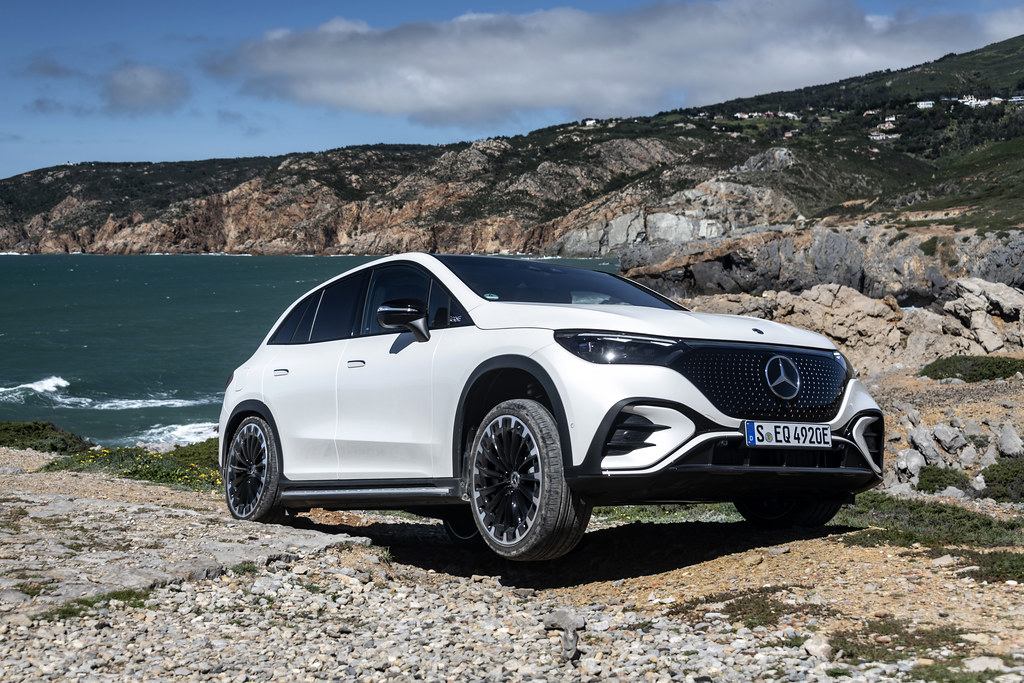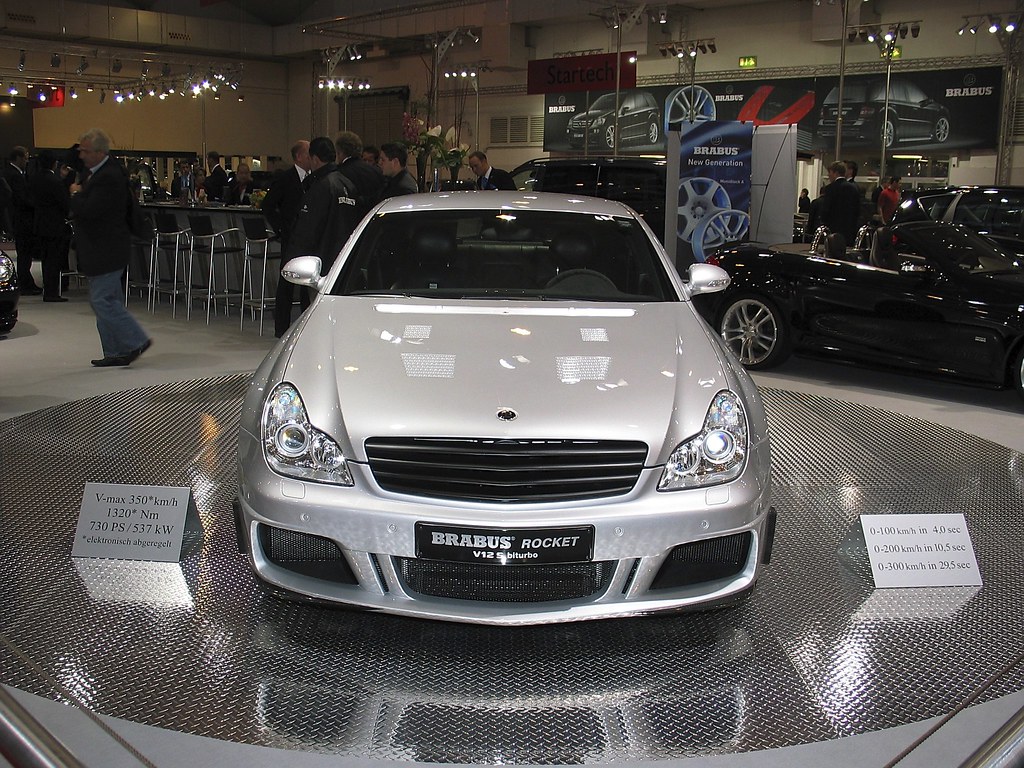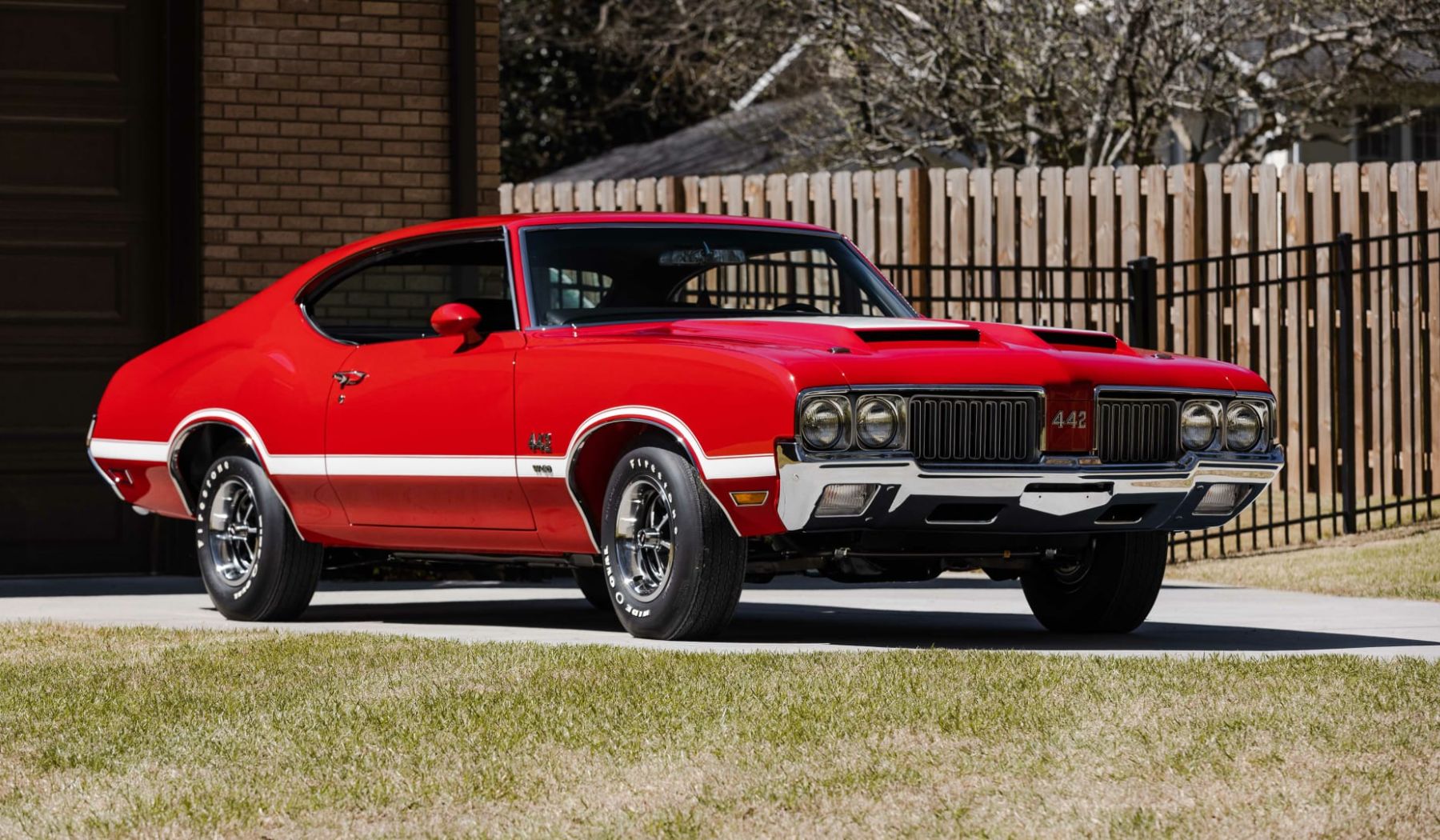
The 1950s marked a thrilling epoch in American history, a time when the nation’s economy was booming, and an insatiable demand for novelty and excitement swept across the land. It was the dawn of the ‘Jet Age,’ a period profoundly influenced by the sleek lines of aerospace design and a pervasive sense of space-age optimism. Automobile manufacturers, caught in an all-out product war, responded with unparalleled creativity, transforming the mundane act of driving into an experience of pure futurism.
Detroit’s offerings during this era were often characterized as ‘irrational excess,’ a testament to their flashy designs, abundant chrome, wild tail fins, and powerful engines. These vehicles weren’t merely modes of transport; they were bold statements, embodying the era’s fascination with speed and advanced technology. They catered to a new segment of the buying public, the ‘Jetsetter,’ who sought not just luxury and performance, but also the prestige of owning a piece of the future.
From the styling studios of General Motors, Ford, Chrysler, and others emerged technological and design breakthroughs that continue to captivate enthusiasts today. We’re about to embark on a journey through some of the most spectacular classic cars that perfectly captured the essence of the Jet Age, packed with details on their specifications, performance, and interiors, allowing you to truly feel the pulse of this unforgettable era.

1. **1956 Buick Centurion**Picture a car that truly looked like it had rolled straight out of a science fiction movie, and you’re likely envisioning the 1956 Buick Centurion. This magnificent concept vehicle, a showstopper at GM’s Motorama, pushed the boundaries of automotive design with its futuristic aesthetics. Its fiberglass body, a revolutionary material for the time, was complemented by a distinctive glass bubble top that gave occupants an expansive view of the world, much like a pilot in a jet cockpit.
What truly defined the Centurion’s Jet Age appeal were its rear fins, dramatically sculpted to scream ‘jet fighter.’ These fins weren’t just for show; they embodied the era’s obsession with aviation, giving the car a sense of speed and forward motion even when standing still. The Centurion was more about visual impact than raw speed, but its 325 hp 322 V8 engine was still capable of pushing it to a respectable 120 mph, demonstrating that even a show car could pack a punch.
The interior of the Centurion was just as groundbreaking as its exterior. It featured an early form of a rearview camera, with a TV camera feeding images to a dashboard screen, a truly visionary piece of technology for the mid-1950s. The cabin, adorned in a striking red-and-white color scheme, boasted a wraparound dash that further enhanced the feeling of being in a cockpit, blending a 1950s diner aesthetic with high-tech aviation design. This was GM design chief Harley Earl’s personal ride for a time, a testament to its singular status, as only one was ever built.
Read more about: Beyond the Chrome: A Deep Dive into 12 Iconic 1960s Luxury Car Ads That Defined a Golden Era of Automotive Storytelling

2. **1955 Chrysler Falcon**The 1955 Chrysler Falcon was a striking two-seater concept car that undoubtedly aimed to rival the then-nascent Corvette. Designed by the legendary Virgil Exner, its sleek body was a masterclass in Jet Age minimalism and aerodynamics. It featured a remarkably low nose and subtle yet impactful tail fins, a design language that unmistakably mimicked the graceful profile of a jet aircraft in flight, suggesting speed and advanced engineering.
Underneath its elegant exterior, the Falcon was powered by a 276 V8 engine, producing a robust 170 horsepower. This powertrain allowed the car to achieve 0–60 mph in approximately 10 seconds, and reach a top speed near 115 mph, which was quite impressive for its time. While it never made it to production, these performance figures hinted at the serious potential the Falcon held to be a true American sports car, blending style with substance.
Stepping inside the Falcon revealed an interior crafted for the discerning driver. It was a tight, focused space, featuring bucket seats that cradled the occupants securely. The simple gauge cluster was angled purposefully toward the driver, evoking the feeling of piloting a fighter jet. This design choice underscored the car’s sporty intentions, emphasizing the connection between man and machine. Although the Falcon remained a concept, its distinctive look and forward-thinking design significantly influenced later Chrysler designs, most notably the iconic 300 series.
Read more about: Boomers, Get Ready to Rev! These 12 Iconic ’60s Car Models Still Drive Our Dreams
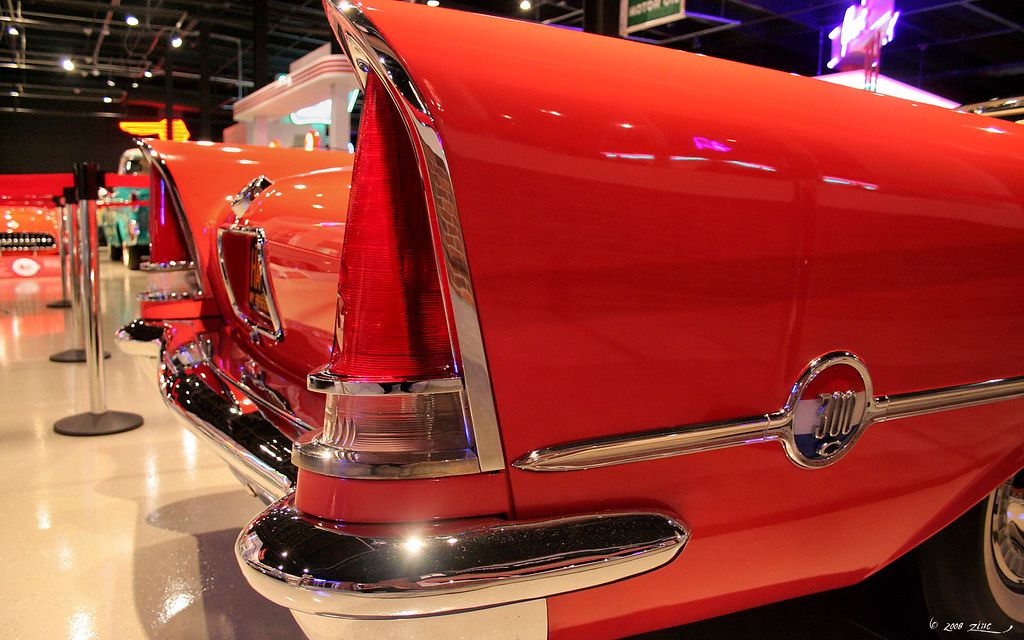
3. **1957 Chrysler 300C**The 1957 Chrysler 300C stands as a true titan of the Jet Age, a magnificent ‘beast’ that perfectly encapsulated the era’s desire for both opulent style and raw performance. It represented the absolute pinnacle of the famous 300 letter-series cars, designed explicitly for the discerning ‘Jetsetter’ who demanded nothing less than the best. This car was not just about getting from point A to point B; it was about making an entrance and setting records.
Under the hood resided the legendary 392 Hemi V8 engine, a powerhouse pumping out an astonishing 375 horsepower through dual-quad carburetors. This immense power translated into breathtaking performance, with the 300C rocketing from 0–60 mph in a mere 7.8 seconds and achieving an incredible top speed of 145 mph. It set the bar at Daytona for speed records, including an unofficial Stock Car record at 145.7 mph, and an average speed of 134 mph at the Daytona Flying Mile, truly making it a ‘luxury Jet Age hot rod.’
Visually, the 300C exuded confidence and aggression, with its sharply peaked tail fins and a wide grille that resembled a jet intake, a common motif of the Jet Age. But its allure extended beyond brute force and aggressive styling. The interior was a sanctuary of luxury, featuring sumptuous leather seats, a convenient pushbutton TorqueFlite automatic transmission, and even optional air conditioning—a rare and coveted feature for the time. Additional luxury appointments included power steering, power brakes, power windows, Solex safety glass, a six-way power front seat, an all-leather interior, a rear defroster, an upgraded lighting package, and an AM Electro-Touch radio.
To truly appreciate a car like the 300C, one only needed to lift the hood to reveal the massive Hemi engine, a sight that brought smiles to owners. This early muscle car, a favorite of the Jetsetter crowd, seamlessly combined overwhelming power—420 lbs./ft. of torque—with undeniable style. Its limited production numbers, with only 484 convertibles and 1,918 300C coupes produced in 1957, only added to its exclusive appeal and bragging rights, making it an icon of automotive excellence.
Car Model Information: 2016 Chrysler 300C Platinum
Name: Chrysler 300
Aka: Lancia Thema
Manufacturer: Chrysler (automotive brand)
Production: February 1, 2004– December 2023
ModelYears: 2005–2023
Class: Executive car
Layout: Front-engine, rear-wheel-drive layout,automobile layout
Predecessor: Chrysler 300M,Chrysler Concorde,Chrysler Intrepid
Categories: 2010s cars, All articles with dead external links, All articles with unsourced statements, Articles with dead external links from June 2025, Articles with short description
Summary: The Chrysler 300 is a full-size car manufactured and marketed by Stellantis North America and its predecessor companies. It was available as a four-door sedan and station wagon in its first generation (model years 2005–2010), and solely as a four-door sedan in its second generation (model years 2011–2023).
The second generation 300 was marketed as the Chrysler 300C in the United Kingdom and Ireland and as the Lancia Thema in the remainder of Europe.
Get more information about: Chrysler 300
Buying a high-performing used car >>>
Brand: Chrysler Model: 300C
Price: $16,257 Mileage: 100,592 mi.
Read more about: Don’t Get Stranded: 14 Used Cars That Will Absolutely Drain Your Wallet After 100,000 Miles
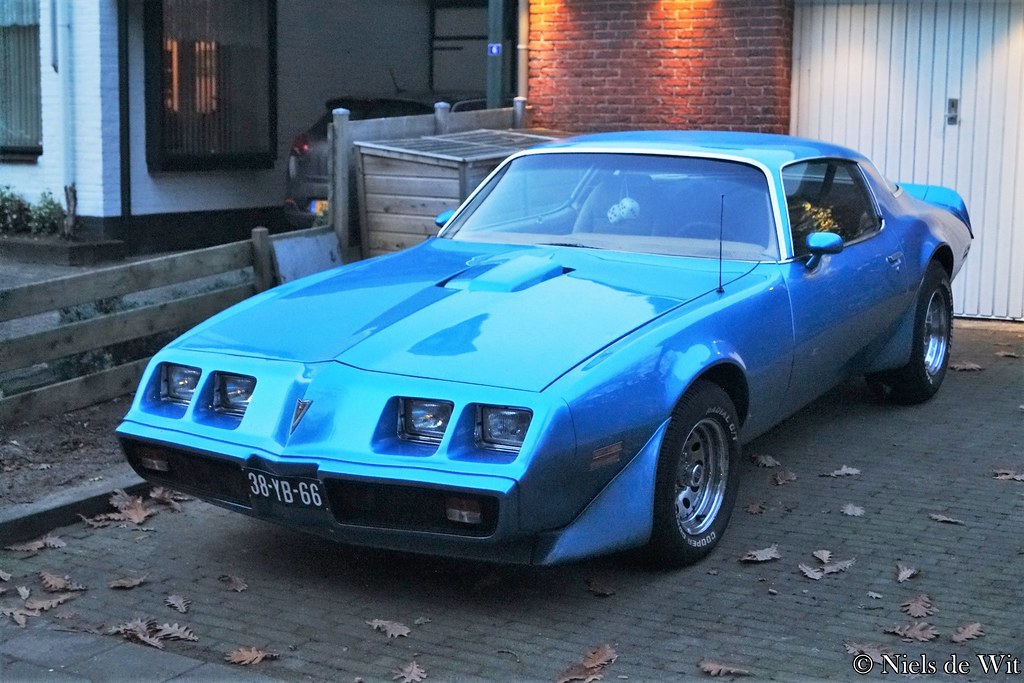
4. **1956 Pontiac Club de Mer**Emerging as another visionary concept from the Jet Age, the 1956 Pontiac Club de Mer looked absolutely ready to soar off the showroom floor. This one-off dream car was a striking display of avant-garde design, intended to showcase Pontiac’s aspirations for the future. Its aluminum body contributed to its lightweight and sleek profile, giving it an almost ethereal presence that was unlike anything else on the road, or indeed, not on the road at all.
The Club de Mer featured a distinctive, low, shark-like nose that contributed to its aerodynamic and aggressive stance. Perhaps its most dramatic Jet Age flourish came in the form of its fins, which were ingeniously designed to flip up, revealing the headlights beneath—a pure piece of automotive theater. This innovative approach to lighting and bodywork highlighted the era’s fascination with hidden features and a clean, uninterrupted design aesthetic, directly inspired by aircraft design.
Powering this magnificent concept was a 287 V8 engine, delivering an impressive 300 horsepower. While it never hit the road and therefore no performance data exists, this ‘serious grunt’ indicated that Pontiac was not just focused on styling but also on delivering potent engines. The interior, though never truly functional for production, featured aeronautical screens and a minimalist dash, prioritizing style and a futuristic feel over everyday utility. Displayed prominently at Motorama, the Club de Mer, despite never reaching production, left an indelible impression and remains a celebrated example of Jet Age design ambition.
Car Model Information: 2022 Honda Civic Sport
Name: Pontiac Club de Mer
Aka: XP-200 / SO 2488
Manufacturer: Pontiac (automobile)
Class: Concept car,sports car
Production: 1956 (one prototype built)
BodyStyle: Roadster (automobile)
Engine: 287 cuin
Abbr: on
Transmission: transaxle
Length: 180.001 in
Height: 38.401 in
Wheelbase: 103.251 in
Predecessor: Pontiac Strato-Streak
Successor: Pontiac Banshee
Categories: Articles with short description, Pontiac concept vehicles, Short description is different from Wikidata
Summary: The Pontiac Club de Mer was a purpose-built, experimental car that was built by Pontiac for the General Motors Motorama in 1956 to celebrate General Motors’ commitment to futuristic design. The brainchild of GM engineer-designer, Harley Earl (Paul Gillian was also involved, being the Pontiac Studio head at the time), the “de Mer”, or French for “of the sea”, was a two-door sport roadster that incorporated innovative breakthrough styling like a sleek, low-profile body encasing a large powerplant, a design trend used widely in LSR (land speed record) trials at Bonneville Salt Flats in Utah during the 1950s. One Club de Mer prototype was constructed and unveiled, along with another quarter-scale model, in Miami, Florida. As per GM’s “kill order”, it was reportedly scrapped in 1958.
Only the model exists today, which was owned by Joseph Bortz of Highland Park, IL. until it was sold to noted car collector Ron Pratt at the 2007 Barrett-Jackson Classic Car Auction for $75,000. A running replica based on a 1959 Pontiac chassis was also built by Marty Martino. Taking three years to complete, it sold for $110,000 at the 2009 Barrett-Jackson Auction in Arizona.
Get more information about: Pontiac Club de Mer
Buying a high-performing used car >>>
Brand: Pontiac Model: Club de Mer
Price: $25,849 Mileage: 16,061 mi.
Read more about: Inside Vanilla Ice’s Garage: A Deep Dive into the Rapper’s Eclectic and Multi-Million Dollar Automotive Collection

5. **1958 Oldsmobile 98 J2 Golden Rocket**The 1958 Oldsmobile 98 J2 Golden Rocket was a veritable ‘chrome-heavy monster’ that perfectly epitomized the Jet Age’s flair for extravagance and performance. This vehicle was a bold statement, representing the era’s penchant for ‘flash and chrome,’ ensuring that its presence was felt both visually and audibly. For the Jetsetter who craved that extra kick in performance, the J2 option (code W) was the ultimate choice, transforming an already luxurious car into a true street contender.
Under the hood, the Golden Rocket housed a potent 371 V8 engine, further enhanced by the J2 option which included three two-barrel carburetors. These carburetors were linked together via a progressive throttle linkage, optimizing fuel delivery for enhanced power. With its compression bumped to 10.0:1, this setup produced a formidable 312 horsepower at 4,600 RPM and an impressive 415-lbs./ft. of torque. Despite weighing over 4,500 pounds and sitting on a substantial 126.5-inch wheelbase, the car could effortlessly cruise at 85 mph in quiet comfort, a testament to its refined engineering.
The exterior of the Olds 98 J2 proudly sported the era’s signature peaked fins and a wide grille, giving it the appearance of a jet on wheels. Its design philosophy was encapsulated by the statement, ‘When too much was not enough,’ reflecting the car’s generous application of chrome and distinctive styling cues, including color-keyed hub caps with faux spinners. This was the top-of-the-line model for Oldsmobile in 1957 and continued to reflect why they created such a luxurious and powerful automobile.
The interior was a testament to luxury and innovation, featuring a stunning tri-tone trimmed design, a ‘transportable’ AM radio (a novel feature for its time), and a padded dash for enhanced safety. The driving experience was further augmented by a Jetaway four-speed Hydramatic transmission, optional air-ride suspension, and robust 11-inch drum brakes. The combination of the J2 option’s performance and the car’s flashy style made it an undeniable favorite for those seeking both speed and status on the burgeoning highways of the Jet Age.”
},
{“_words_section1”: “1997
The Jet Age, with its boundless optimism and fascination with all things fast and futuristic, didn’t just give us glimpses of what could be through concept cars; it also inspired production vehicles that brought a taste of tomorrow to the roads of today. As we continue our journey through this golden era of automotive design, we’ll encounter five more masterpieces that perfectly embody the spirit of the Jetsetter, each a testament to the era’s ambition and ingenuity. From supercharged muscle to spacecraft-inspired concepts, these cars left an indelible mark on history.
Car Model Information: 2022 Honda Civic Sport
Name: Oldsmobile 88
Caption: 1996 Oldsmobile Eighty Eight LS
Manufacturer: Oldsmobile
ModelYears: 1949–1999
Class: Full-size car
Layout: FR layout
Predecessor: Oldsmobile L-Series
Successor: Oldsmobile Aurora
Categories: 1940s cars, 1950s cars, 1960s cars, 1970s cars, 1980s cars
Summary: The Oldsmobile 88 (marketed from 1989 on as the Eighty Eight) is a full-size car that was produced by the Oldsmobile Division of GM from 1949 until 1999. From 1950 until 1974, the 88 was the division’s most popular line, particularly the entry-level models such as the 88 and Dynamic 88. The 88 series was also an image leader for Oldsmobile, particularly in the model’s early years (1949–51), when it was one of the best-performing automobiles, thanks to its relatively small size, light weight, and advanced overhead-valve high-compression V8 engine. This engine, originally designed for the larger and more luxurious C-bodied 98 series, also replaced the straight-8 on the smaller B-bodied 78. With the large, high performance Oldsmobile Rocket V8, the early Oldsmobile 88 is considered by some to be the first muscle car.
Naming conventions used by GM since the 1910s for all divisions used alphanumeric designations that changed every year. Starting after the war, Oldsmobile changed their designations and standardized them so that the first number signified the chassis platform, while the second number signified how many cylinders. A large number of variations in nomenclature were seen over this long model run — Super, Golden Rocket, Dynamic, Jetstar, Delta, Delmont, Starfire, Holiday, LS, LSS, Celebrity, and Royale were used at various times with the 88 badge, and Fiesta appeared on some station wagons in the 1950s and 1960s. The name was more commonly shown as numerals in the earlier years (“Delta 88”, for example) and was changed to spell out “Eighty Eight” starting in 1989.
Get more information about: Oldsmobile 88
Buying a high-performing used car >>>
Brand: Oldsmobile Model: 98 J2 Golden Rocket
Price: $25,849 Mileage: 16,061 mi.
Read more about: Ten Iconic Jet Age Dream Machines: Unpacking the Designs, Power, and Legacy of Mid-Century Automotive Innovation
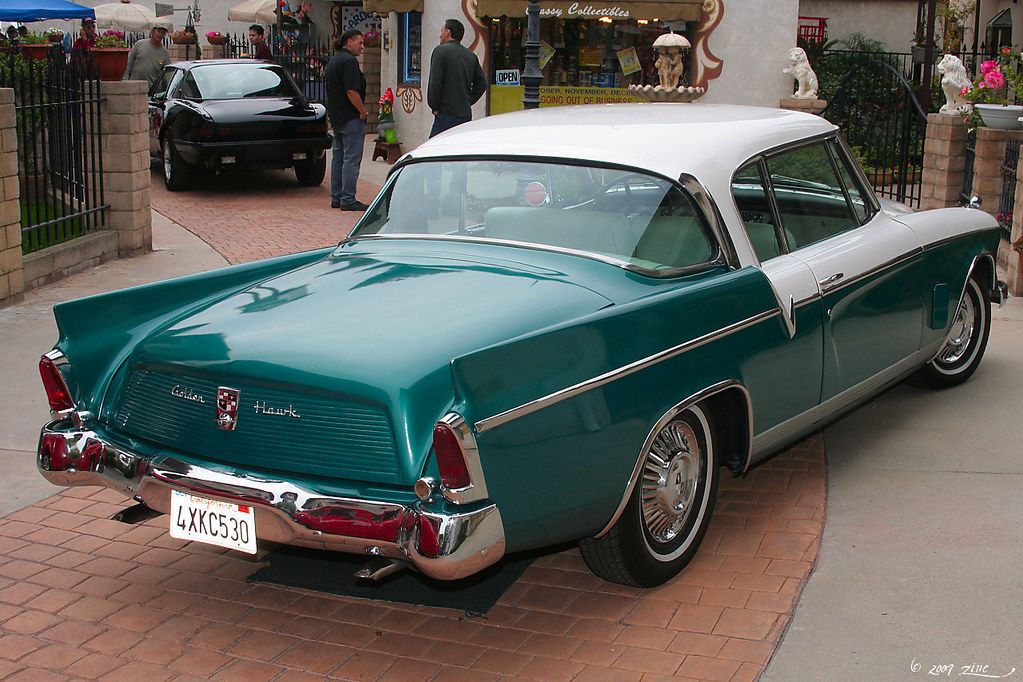
6. **1956 Studebaker Golden Hawk**The 1956 Studebaker Golden Hawk burst onto the scene as a true blend of jet-inspired aesthetics and serious, competitive power. Available as a striking two-door pillarless hardtop coupe, it immediately distinguished itself with sleek lines and modest, yet effective, tail fins that gave it a distinct fighter-jet vibe. This was a car that confidently announced its presence without needing the wild excesses seen on some contemporaries.
What truly set the Golden Hawk apart was its performance. It featured a 289 cu.in. V-8 engine, dramatically enhanced by the addition of a McCulloch supercharger, pushing its output to a formidable 275 horsepower. This robust powertrain, coupled with an excellent power-to-weight ratio, allowed it to rocket from 0-60 mph in approximately 7.8 seconds, a figure that, for the time, outran rivals like the Corvette and Thunderbird, placing it second only to the mighty Chrysler 300B in sheer speed. To accommodate the supercharger, a distinctive fiberglass overlay was integrated into the hood, a subtle yet functional nod to its performance capabilities.
The interior of the Golden Hawk offered a refined experience for its occupants. It boasted a padded dash, a clear indication of a growing emphasis on safety, and a practical vacuum gauge on the instrument panel, providing drivers with essential feedback. The cabin comfortably accommodated three passengers in the rear, adding a touch of family-friendly utility to its sporty demeanor. In 1957, Studebaker even introduced a luxury 400 model, a limited run of just 41 units featuring sumptuous leather interiors, a fully upholstered trunk, and special trim, catering to the most discerning Jetsetters.
While later model years, like the 1958 Golden Hawk, saw a switch to 14-inch wheels for a slightly lower ride and sales affected by an economic recession, the 1956 model cemented its legacy. It stands as a rare gem, with 4,071 units built in its inaugural year, holding its own against more established names and offering bragging rights to those who appreciated its unique blend of power, style, and exclusivity. The Golden Hawk wasn’t just a car; it was a statement of performance and sophistication from an independent automaker.
Car Model Information: 2022 Honda Civic Sport
Layout: FR layout
Caption: 1956 Studebaker Golden Hawk
Name: Studebaker Golden Hawk
Manufacturer: Studebaker
Assembly: Studebaker Corporation#Studebaker Factories,South Bend, Indiana,United States,Studebaker Canada,Hamilton, Ontario,Canada
BodyStyle: hardtop
Categories: All articles needing additional references, All articles with unsourced statements, Articles needing additional references from June 2011, Articles with short description, Articles with unsourced statements from January 2016
Summary: The Studebaker Golden Hawk is a two-door pillarless hardtop personal luxury car produced by the Studebaker Corporation of South Bend, Indiana, between 1956 and 1958.
Get more information about: Studebaker Golden Hawk
Buying a high-performing used car >>>
Brand: Studebaker Model: Golden Hawk
Price: $25,849 Mileage: 16,061 mi.
Read more about: Beyond the Chrome: A Deep Dive into 12 Iconic 1960s Luxury Car Ads That Defined a Golden Era of Automotive Storytelling
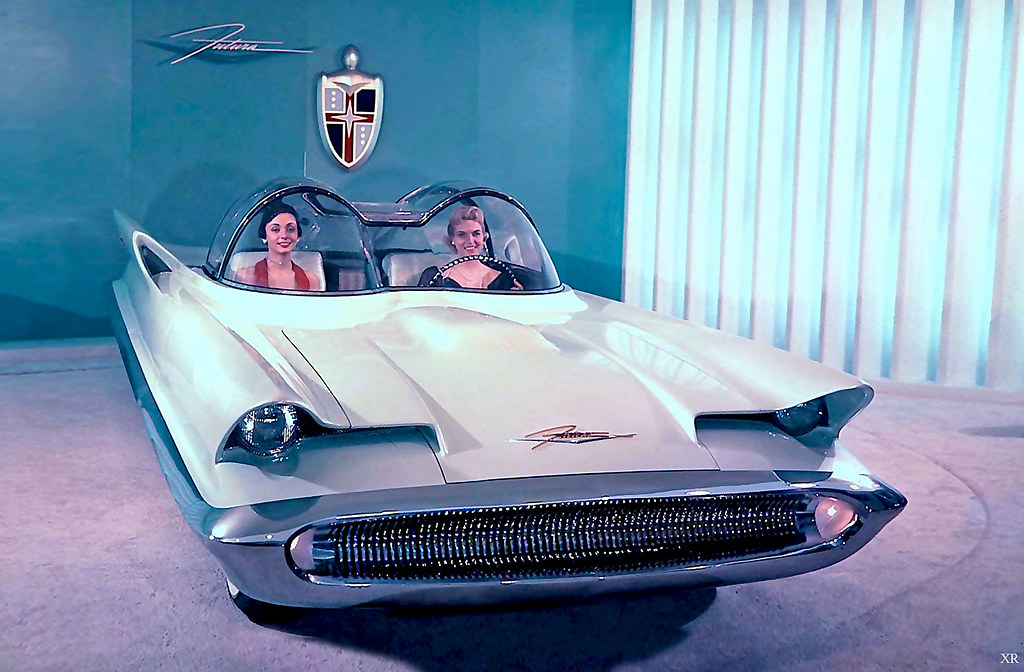
7. **1955 Lincoln Futura**Prepare to be transported to another dimension with the 1955 Lincoln Futura, a concept car that looked less like an automobile and more like it belonged in orbit. This breathtaking creation was an exercise in pure, unadulterated Jet Age imagination, pushing the boundaries of what a car could be. Its very purpose wasn’t about setting speed records but about defining an aesthetic that screamed ‘the future is now.’
The Futura’s design was truly out of this world, dominated by a double-domed canopy that offered panoramic views and evoked the cockpit of a spacecraft. Sharp, pronounced fins swept back dramatically, mirroring the elegant fuselage of a jet aircraft. Every line and curve on its body was meticulously sculpted to create an unparalleled sense of motion and advanced engineering, making it a definitive symbol of Jet Age excess and visionary styling. Powering this futuristic marvel was a 368 V8 engine, producing approximately 225 horsepower, yet its true force lay not in raw speed but in its overwhelming visual impact.
Stepping inside the Futura was an equally immersive experience. The wraparound dash, complete with an array of analog gauges and innovative pushbutton controls, further enhanced the feeling of piloting an advanced craft. It was a space meticulously crafted to convey technological sophistication, blending luxury with a stark, modern sensibility. This one-off show car, however, never reached production, remaining a singular beacon of design ambition.
The enduring legacy of the Lincoln Futura is perhaps best known through its dramatic transformation. Later painted pearl white, it was famously reimagined as the iconic 1966 Batmobile, cementing its place not just in automotive history but in pop culture as well. This incredible vehicle, originally a spectacular display of mid-century American futurism, continued to captivate audiences for decades, proving that its avant-garde lines were truly timeless.
Read more about: Beyond the Chrome: Unearthing 12 of the Rarest Hidden Gems of 1950s American Automotive History

8. **1951 GM LeSabre**Before the dawn of some of the wilder Jet Age creations, the 1951 GM LeSabre emerged as an early, pivotal rolling experiment, showcasing Harley Earl’s visionary genius. This wasn’t merely a concept car; it was a bold declaration of intent, a testbed for future technologies and design elements that would eventually trickle down into production vehicles. It truly embodied the spirit of innovation that defined General Motors during this exciting period.
Crafted with an aluminum body, the LeSabre featured elegantly swept-back fins and a distinctive jet-inspired nose, a direct nod to the burgeoning aviation age. Its streamlined form hinted at speed and efficiency, embodying a forward-thinking design philosophy. Underneath its sleek exterior lay a supercharged 215 V8 engine, which generated an impressive 335 horsepower. This considerable power allowed the car to achieve 0-60 mph in approximately 9 seconds, an incredibly fast figure for its time, demonstrating that Earl was as much about performance as he was about pushing design boundaries.
The interior of the LeSabre was a true marvel of engineering and futuristic convenience. It boasted a moisture sensor designed to automatically raise the convertible top, a feature that was astonishingly advanced for the era. Electric windows provided effortless control, while the futuristic dashboard, adorned with aircraft-style gauges, placed the driver firmly in a cockpit-like environment. It was a blend of cutting-edge technology and sophisticated aesthetics, making every drive an experience in pioneering luxury.
After its initial tour as a show car, the LeSabre served as Harley Earl’s personal daily driver, a testament to its practicality and the confidence he had in its revolutionary features. This practical application of a concept vehicle allowed for real-world testing and refinement, influencing later, iconic GM designs. Notably, its pioneering spirit can be seen reflected in future models such as the Cadillac Eldorado, making the LeSabre a foundational piece in the tapestry of Jet Age automotive heritage.
Read more about: Beyond the Chrome: A Deep Dive into 12 Iconic 1960s Luxury Car Ads That Defined a Golden Era of Automotive Storytelling

9. **1956 Firebird II**Imagine a car that bypassed the conventional gasoline engine entirely, and you’re conjuring up the incredible 1956 GM Firebird II. This titanium-bodied concept car was not just a design study; it was a grand declaration of GM’s audacious vision for the future of personal transportation. It pushed beyond traditional automotive engineering, venturing into realms previously reserved for aircraft.
At the heart of the Firebird II was a revolutionary 200 horsepower gas turbine engine, a powerplant that idled at an astonishing 22,000 rpm. While it promised a theoretical top speed of 200 mph, its operation was so intensely noisy that it necessitated ear protection for occupants, highlighting the experimental nature of such advanced propulsion. The vehicle was even designed with an eye toward autonomous “guided roadways,” a truly visionary concept that predicted the future of intelligent transport decades in advance.
The exterior design of the Firebird II was unmistakably drawn from the aerospace industry. Its iconic bubble canopy provided an unobstructed view, reminiscent of a jet fighter’s cockpit, and its dramatic tail fins were straight out of a playbook for supersonic aircraft. Every element of its titanium body, from its sleek profile to its distinctive exhaust, screamed ‘jet power’ and ‘space-age travel,’ solidifying its image as a vehicle from a future yet to arrive.
Inside, the Firebird II was nothing short of a rolling sci-fi lounge. It featured a built-in television, comfortable swiveling seats for ease of entry and interaction, and even a compact refrigerator, transforming the act of travel into a luxurious, futuristic experience. Though it never reached production, the Firebird II stands as a testament to GM’s wild ambitions during the Jet Age, a bold, titanium dream that showcased the boundless possibilities of automotive innovation.
Car Model Information: 2022 Honda Civic Sport
Categories: All articles with unsourced statements, Articles with short description, Articles with unsourced statements from June 2014, Cars powered by gas turbines, Commons category link is on Wikidata
Summary: The General Motors Firebird comprises a quartet of prototype cars that General Motors (GM) engineered for the 1953, 1956, and 1959 Motorama auto shows. The cars’ designers, headed by Harley Earl, took Earl’s inspiration from the innovations in fighter aircraft design at the time. General Motors never intended the cars for production, but rather to showcase the extremes in technology and design that the company was able to achieve.
GM preserved the prototype cars at the GM Heritage Center in Sterling Heights, Michigan. Models of the cars are in the permanent collection of the Henry Ford Museum in Dearborn, and the cars still make regular appearances at car shows.
The tradition of offering prototype vehicles continued with the Pontiac Banshee series. From 1967 to 2002, the Pontiac division of GM marketed its Firebird line of pony cars, which had no direct relation to these series of Firebird concept cars.
Get more information about: General Motors Firebird
Buying a high-performing used car >>>
Brand: GM Model: Firebird II
Price: $25,849 Mileage: 16,061 mi.
Read more about: Unearthing Automotive Gold: 10 Jaw-Dropping ’70s Muscle Cars You Can Still Own for a Steal

10. **1961 Ford Thunderbird**While many Jet Age marvels remained in the realm of concepts and dreams, the 1961 Ford Thunderbird bravely brought this futuristic style directly to the production line, cementing its status as a cultural icon. This generation of the Thunderbird, often referred to as the “Bullet Bird” for its sleek, projectile-like styling, proved that Jet Age allure could be mass-produced and enjoyed by a wide audience.
Underneath its elegant hood, the 1961 Thunderbird was powered by a robust 390 V8 engine, delivering a substantial 300 horsepower. This power translated into impressive road performance, allowing the car to accelerate from 0-60 mph in approximately 8.5 seconds and reach a top speed of 125 mph. It provided a compelling blend of luxury and spirited performance, making it a favorite for the discerning Jetsetter who wanted both comfort and excitement in their drive.
The exterior design was a masterclass in applying Jet Age themes to a mainstream vehicle. A distinctive jet-tube grille dominated the front, while subtle yet impactful tail fins gracefully flowed into the rear, evoking the powerful silhouette of a fighter jet. This cohesive design language made the Thunderbird instantly recognizable and highly desirable, representing the era’s optimism and fascination with speed and flight. It truly looked like it was designed to slice through the air with effortless grace.
Inside, the Thunderbird offered a truly unique and luxurious experience. The innovative “Swing-Away” steering wheel pivoted to the side, allowing for remarkably easy entry and exit, a testament to its thoughtful design. A wraparound dash, accented with gleaming chrome-accented gauges, created a sophisticated cockpit feel, enveloping the driver in an environment that blended aircraft-inspired controls with opulent comfort. Available as both a coupe and a convertible, the 1961 Thunderbird sold over 73,000 units, becoming a defining symbol of American style and prosperity, and a timeless classic that continues to captivate enthusiasts with its blend of Jet Age flair and everyday drivability.
Car Model Information: 2003 Ford Thunderbird
Name: Ford Thunderbird
Caption: 1957 Thunderbird
Manufacturer: Ford Motor Company
Production: unbulleted list
ModelYears: unbulleted list
Class: unbulleted list
Layout: Front-engine, rear-wheel drive layout
Categories: 1960s cars, 1970s cars, 1980s cars, 1990s cars, 2000s cars
Summary: The Ford Thunderbird is a personal luxury car manufactured and marketed by Ford Motor Company for model years 1955 to 2005, with a hiatus from 1998 to 2001.
Ultimately gaining a broadly used colloquial nickname, the T-Bird, the model was introduced as a two-seat convertible, subsequently offered variously in a host of body styles including as a four-seat hardtop coupe, four-seat convertible, five-seat convertible and hardtop, four-door pillared hardtop sedan, six-passenger hardtop coupe, and five-passenger pillared coupe, before returning in its final generation, again as a two-seat convertible.
At its inception, Ford targeted the two-seat Thunderbird as an upscale model. The 1958 model year design introduced a rear seat and arguably marked the expansion of a market segment that came to be known as personal luxury cars, positioned to emphasize comfort and convenience over handling and high-speed performance.
Get more information about: Ford Thunderbird
Buying a high-performing used car >>>
Brand: Ford Model: Thunderbird
Price: $14,500 Mileage: 49,430 mi.
Read more about: Don’t Fall for the Hype: The 15 Cars That Look Absolutely Stunning But Drive Terribly
Our journey through the Jet Age’s automotive landscape reveals more than just magnificent machines; it uncovers a profound cultural moment when innovation, optimism, and extravagant design converged. These ten vehicles, from visionary concepts to iconic production models, are not just relics of the past; they are enduring symbols of a time when the future seemed limitless, and the road ahead was paved with chrome and dreams. They remind us that sometimes, the most impractical ideas can inspire the most beloved classics, forever capturing the spirit of an age that truly aimed for the sky.

